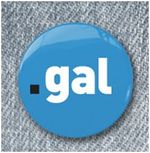.gal
 | |
| Status: | Proposed |
| country: | Spain |
| Language: | Galician Language |
| Manager: | Asociación PuntoGal |
| Registry Provider: | CORE |
| Type: | Community TLD |
| Category: | Culture |
| More information: | |
.gal is a proposed top level domain name (TLD) for the Galician language and culture by Asociación puntoGAL to ICANN's New gTLD Program. As registry operator for the TLD, the organization aims to establish an online space and promote an online identity for the Galician people and to be able to share their culture and language globally. The application for the .gal TLD is supported by more than 13,000 individuals and numerous organizations.Manuel González is the President of the organization.[1]
It can be seen as building upon the success of .cat as an extension for the Catalan community, which was introduced in 2005. It is being applied for by The Asociación puntoGAL; members of the association include the most authoritative Galician language authority, The Real Academia Galega (RAG). Registrants will be required tos tate their intended use for the domain; a false statement is grounds for removal of the domain and of future participation in the community TLD.[2]
Application Details edit
The folllowing is excerpted from the applicant's response to question #18:
"Registrations under the .gal TLD are restricted to bona-fide members of the Galician linguistic and cultural community, and subject to the further requirement that the registrant’s actions in the .gal TLD community, as well as the registrant’s use of the registered domain name, must be:
(i) generally accepted as legitimate; and
(ii) beneficial to the cause and the values of the Galician linguistic and cultural community; and
(iii) commensurate with the role and importance of the registered domain name; and
(iv) in good faith at the time of registration and thereafter.
The registration policies are differentiated between Pre-launch phase, Launch phase and General Availability.
..
At General Availability, community nexus is subject to post-validation by way of an extensive compliance program based on the same criteria that form the basis of the TLD: language and culture. The ongoing compliance program will regularly be adapted to current needs based on experience and audit findings. Community nexus validation combined with strong protection of trademarks helps stamp out cybersquatting and abusive registrations."[3]
References edit
- ↑ The Galician Language will participate in the call for new internet domains
- ↑ Application 1-1278-425
- ↑ Application Download, gTLDresult.ICANN.org Retrieved 19 Feb 2013